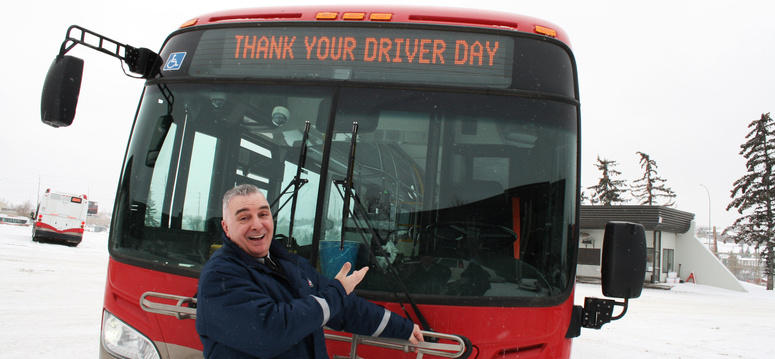March 17, 2017
Stop and thank your transit driver!

Like most of us, Calgary Transit operator Mike Trigiani likes being appreciated for his hard work.
Calgary Transit and UCalgary associate professor Suzanne Goopy want you to take the time to acknowledge the 2,000-plus hard-working CTrain, bus, shuttle and Calgary Transit Access operators on Friday, March 17, for Thank Your Driver Day. The official Thank Your Driver Day is Saturday, March 18.
In the 2015 partnership with the City of Calgary and Calgary Transit, Goopy, using images of transit riders’ shoes, launched the #empathyconnects project where she invited us to meet an array of Calgary transit riders, read their stories and find connections. Thank Your Driver Day launches the next phase of the EMPaThY? collaboration with a focus on the hands (and the people) who drive us. The 1,100 ads, visible on buses and CTrains, appeared on March 13 and will be up for four weeks.
“This project seeks to humanize the ride,” Goopy explains. “The deliberate choice of hands is intended to conjure the idiom of ‘being in good hands’ — in the competent and safe care of the driver.”

Suzanne Goopy, PhD, RN
Public transportation is good for you, research says
Research into passenger perceptions and behavioural adaptations is one of the factors prompting Goopy to look at a novel way to increase the empathic connection between transit and its riders. While it is well known that a physically active lifestyle helps reduce the likelihood of diabetes, high blood pressure and obesity, until recently it was unclear whether these risk factors for heart disease and stroke were affected by how people get to work. A Japanese study comparing bus/train commuters, walkers/bikers and drivers found that compared to drivers, public transportation users were:
- 44 per cent less likely to be overweight
- 27 per cent less likely to have high blood pressure
- 34 per cent less likely to have diabetes
Interestingly, the bus/train commuters had even lower rates of diabetes, high blood pressure and obesity than the walkers or bikers.
Do yourself a favour and take transit
“Various studies have shown that riders of transit are more likely to stop using transit and revert to car use when they experience transit delays without fully understanding what the cause is,” says Goopy. “While traffic incidents, mechanical failure and unexpected incidences on a bus or train are part and parcel of the experience of taking transit, riders may stop using the service. They are doing themselves and their health and well-being a disservice.”
By introducing riders to some of the Calgary Transit drivers, Goopy says that she hopes to open up a dialogue through which transit can be better understood. “If riders — and would-be-riders — see a more human side of public transit, perhaps perceptions and behaviour adaptations can also shift,” she says. “The more we can encourage people to see transit as something that is good for their health and not just a way of getting from point A to point B, the better chance we have of getting and keeping riders.
“We need to work with the simple solutions for better health. I am hopeful this campaign encourages riders to give transit a chance and to choose health in the everyday.”
